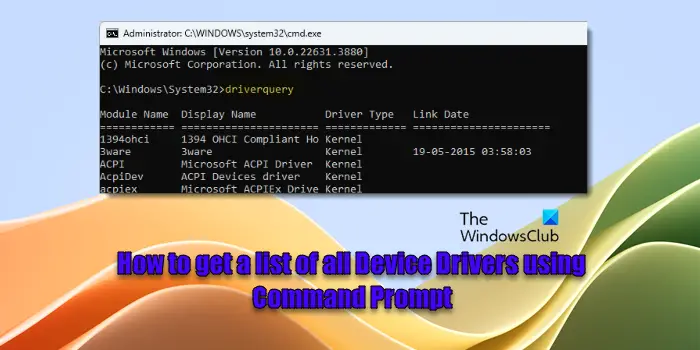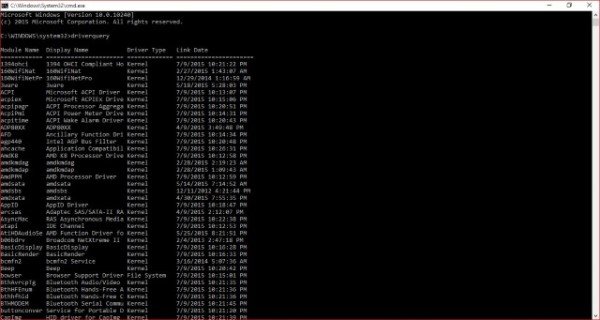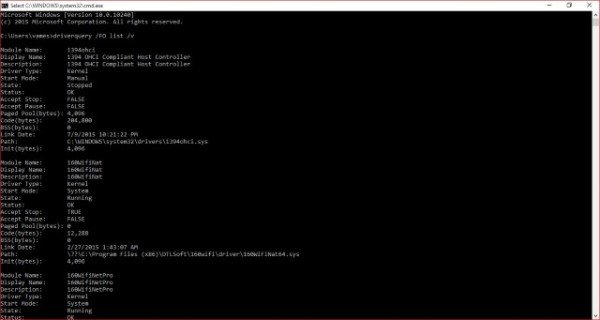Device Drivers are one of the main reasons why your computer is running at optimal performance today; they can also be one of the reasons why your computer is running slowly. When things are running well, computer users might want to view a list of the operational drivers. This can be a difficult process, which is why we are going to talk about how to view a list of all device drivers via the Command Prompt by using the driverquery command.

First, we need to launch the Command Prompt. To do this, users may open the WinX menu in Windows 11 or Windows 10 and click on Command Prompt. Another way is to press the Windows Key along with R and then type CMD in the text box. Hit enter and watch as the Command Prompt launches.
Generate a list of Drivers using driverquery command
In the Command Prompt, enter the command driverquery. This should bring up a list of drivers installed on the system. Depending on the number of drivers installed, it may take a while for the screen to fully populate. A relatively fast computer should perform these tasks within just a few seconds after the user hits the enter button.
Using the driverquery command will show the module name of the driver, along with the display name, driver type, and link date. However, that is not all, because it is possible to generate more information about these drivers just by using a different parameter.
Type driverquery /v to generate a detailed list similar to the one below:
To generate an even more detailed list, use driverquery /FO list /v.
It shows a lot more, including information on whether or not a driver is running. We understand that this one should be more adequate for advanced users, so we would recommend starting things off with driverquery /FO list /v instead of driverquery. Here, the output will be formatted in a list style rather than a table or CSV format.
While using the Command Prompt removes the need for installing another app, some users might not feel right at home, so we suggest using an app called DriverView. It does almost everything driverquery does and more. It is a powerful app, and as such, we recommend it to novices since it is more straightforward than using the Command Prompt.
Read: List Hard Drives using Command Prompt & PowerShell in Windows.
How do I see all device drivers?
You may see all device drivers installed on your Windows 11/10 PC using Device Manager, System Information, and Command Prompt. Press Win + X and select Device Manager. You will see a list of all hardware categories in the Device Manager window. Expand each category to see the devices. Right-click on a device and select Properties. Go to the Driver tab to see driver details for the selected device. Alternatively, open Command Prompt and execute the driverquery command to see a list of all installed drivers.
How to get list of devices using CMD?
To get a list of devices using Command Prompt, you may use the ‘wmic’ or ‘pnputil’ command line utility. wmic allows you to retrieve system information by querying Windows Management Instrumentation while pnputil lets you add, delete, or list driver packages that are currently in the driver store. Open Command Prompt as an administrator and run wmic path Win32_PnPEntity get /format:list command to list all Plug and Play (PnP) devices with their properties. Alternatively, run pnputil /enum-devices command to enumerate and list all devices and their associated driver packages currently installed on the system.
Similar posts that will interest you:
- How to get Installed Driver list and details using PowerShell
- ServiWin and DriverView are free tools that display the list of all device drivers in Windows
- Manage Windows Drivers using DevCon command line tool.



You can also use it like this.
>c:my-file.txt
Or any path like d:my-system-checkup, and I often use txt, rtf and with some diffulty xls as filetype.
C:WINDOWSsystem32>driverquery /v >c:driveres.txt
C:WINDOWSsystem32>driverquery /v >c:driveres.rtf
C:WINDOWSsystem32>driverquery /v >c:driveres.xls
C:WINDOWSsystem32>driverquery /v >”my drive: and my folder”driveres.txt
I’m attempting to do this just like you suggested:
C:WINDOWSsystem32>driverquery /v >c:driveres.txt
But I’m finding that I get a different result from the command line when I run driverquery from ProcessStartInfo in C#.
Any idea why these should give a different result?
There was an error in my first post
C:WINDOWSsystem32>driverquery /v >c:driveres.txt
Try this and look in the C: root
There should be a file named drivers.txt containing the data about your drivers
C:WINDOWSsystem32driverquery /v >c:driveres.txt
Thanks.
I can get the date to output to a file no problem. My problem is that I get a different result if I run manually from a command line and if I have my C# app run the same command. Even if C# runs a .bat file I don’t get all of the records.
am having alot of problems right now
Is there a way to generate a VBscript for automatic driver updates?